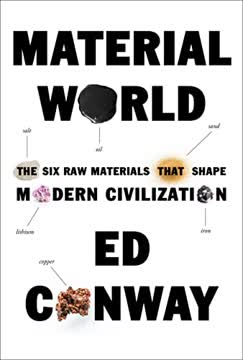Key Takeaways
1. Gray Rhinos: Obvious Threats We Ignore
A Gray Rhino is a highly probable, high-impact threat: something we ought to see coming, like a two-ton rhinoceros aiming its horn in our direction and preparing to charge.
Defining the Obvious. Gray Rhinos are not Black Swans (rare, unpredictable events), but rather highly probable, high-impact threats that we often fail to address despite their obviousness. These threats loom large, like a charging rhinoceros, yet we consistently underestimate their potential impact or delay taking action until it's too late.
Examples of Gray Rhinos. These range from global issues like climate change, unsustainable debt levels, and youth unemployment to personal challenges like neglecting health or financial planning. The common thread is that the warning signs are clear, but we choose to ignore them, often due to complacency, short-term thinking, or conflicting priorities.
The Cost of Ignoring. The consequences of ignoring Gray Rhinos can be devastating, leading to crises that could have been prevented or mitigated with timely action. By recognizing and addressing these obvious threats, we can reduce human and financial costs and create opportunities for growth and innovation.
2. The Perils of Prediction and Denial
We avoid asking the questions for which we don’t want to know the answers, because we don’t want to deal with the consequences of knowing, especially when inconvenient truths get in the way of the stories we tell ourselves about how wonderful things will be if they go the way we’ve told ourselves they would.
The Illusion of Control. Humans tend to overestimate their ability to predict and control the future, leading to a false sense of security and a reluctance to acknowledge potential threats. This optimism bias can blind us to the warning signs of impending crises.
The Comfort of Consensus. We often seek validation from others and conform to prevailing views, even when those views are not based on sound evidence. This herd mentality can stifle critical thinking and prevent us from recognizing outlier opinions that challenge the status quo.
The Power of Denial. Denial is a powerful defense mechanism that allows us to avoid confronting uncomfortable truths. While denial can be a temporary buffer, it becomes dangerous when it prevents us from taking necessary action to mitigate risks.
3. Cognitive Biases: The Mind's Roadblocks
In recent years, behavioral economists have identified many of the cognitive biases that keep us from acting in our best interests, and helped draw much needed attention to the ways in which warped perceptions and emotional and irrational motivations shape the decisions we make.
Understanding Our Irrationality. Cognitive biases are systematic patterns of deviation from norm or rationality in judgment. These biases can distort our perception of risk, influence our decision-making, and prevent us from acting in our best interests.
Common Cognitive Biases:
- Groupthink: The tendency to conform to the prevailing opinion within a group
- Confirmation bias: The tendency to seek out information that confirms existing beliefs
- Availability bias: The tendency to overestimate the likelihood of events that are easily recalled
- Optimism bias: The tendency to overestimate the likelihood of positive events and underestimate the likelihood of negative events
Counteracting Biases. By recognizing these biases, we can develop strategies to mitigate their influence and make more rational decisions. This includes seeking diverse perspectives, challenging assumptions, and relying on data-driven analysis.
4. Muddling Through: The Cost of Inaction
Of all the tricks that human nature plays on us, inertia is one of the most powerful forces preventing us from getting out of the way of a known challenge.
The Temptation of Gradualism. Muddling, or "kicking the can down the road," is a common response to Gray Rhinos. This involves delaying action and addressing problems incrementally, often due to political constraints, lack of resources, or a desire to avoid short-term pain.
The Price of Procrastination. While gradualism may seem like a pragmatic approach, it can lead to higher costs and more limited options in the long run. By delaying action, we allow problems to fester and become more difficult to solve.
The Need for Decisive Action. Overcoming inertia requires strong leadership, a clear vision, and a willingness to make tough decisions. This includes prioritizing long-term goals over short-term gains and challenging the status quo.
5. Diagnosing the Threat: Knowing Your Rhino
Important lessons are to be found in the ways in which leaders, organizations, and countries have or have not responded successfully.
Not All Rhinos Are Created Equal. Different types of Gray Rhinos require different strategies. It's crucial to accurately diagnose the nature of the threat and identify its root causes in order to develop effective solutions.
Types of Gray Rhinos:
- Inconvenient Truths: Widely recognized problems with no easy solutions
- Recurring Rhinos: Predictable events that require ongoing preparedness
- Charging Rhinos: Smoldering issues that suddenly erupt into crises
- Meta-Rhinos: Structural problems that create a range of symptoms
- Conundrums: Problems with no clear answers or easy solutions
Tailoring the Response. By understanding the specific characteristics of each type of Gray Rhino, we can tailor our responses to maximize their effectiveness. This includes prioritizing resources, developing targeted interventions, and fostering collaboration among stakeholders.
6. Panic Mode: Decisions Under Pressure
The fourth stage, panic, moves quickly to the fifth and final stage: action or a trampling, or sometimes both.
The Perils of Hysteria. When a Gray Rhino reaches the panic stage, rational decision-making often breaks down. Fear and uncertainty can lead to impulsive actions, knee-jerk reactions, and a focus on short-term survival.
The Importance of Preparation. The best way to navigate the panic stage is to prepare in advance. This includes developing contingency plans, establishing clear communication channels, and training personnel to respond effectively under pressure.
Maintaining Composure. Leaders must remain calm and composed during times of crisis, providing a steady hand and a clear sense of direction. This requires emotional intelligence, resilience, and the ability to make difficult decisions under pressure.
7. Action and Opportunity: Turning Crisis into Gain
Those who can anticipate a major disruptive change stand to profit. They also can change the world.
Beyond Damage Control. While avoiding a trampling is the primary goal, Gray Rhinos also present opportunities for innovation, growth, and positive change. By embracing a proactive mindset, we can turn threats into catalysts for progress.
Strategies for Turning Crisis into Opportunity:
- Identify new markets and business models
- Develop innovative products and services
- Improve efficiency and sustainability
- Strengthen relationships with stakeholders
The Power of Resilience. Even when a crisis cannot be avoided, resilience allows us to bounce back stronger than before. This includes learning from mistakes, adapting to new realities, and building a more robust and adaptable organization.
8. Long-Term Thinking: Averting Future Tramplings
Leaders need to start by worrying more about Gray Rhinos than about Black Swans, and finding ways to shock themselves out of denial and change our incentive systems to make it easier to respond.
Beyond Short-Term Gains. Our political and financial systems often prioritize short-term gains over long-term sustainability. This creates a bias towards inaction and makes it difficult to address Gray Rhinos before they become crises.
Investing in the Future. Overcoming short-termism requires a shift in mindset and a commitment to long-term thinking. This includes making investments in infrastructure, education, and research that may not yield immediate returns but will create lasting benefits.
Creating a Culture of Foresight. Organizations need to foster a culture that values foresight, encourages critical thinking, and rewards proactive behavior. This includes incorporating long-term considerations into decision-making processes and promoting a sense of shared responsibility for the future.
9. The Power of Systems: Building Resilience
We need a better way of thinking about Gray Rhinos: a framework for recognizing, prioritizing, and handling these highly obvious threats before it’s too late.
Beyond Individual Action. While individual awareness and action are important, systemic changes are necessary to address Gray Rhinos effectively. This includes creating early warning systems, establishing clear lines of accountability, and aligning incentives to promote proactive behavior.
Examples of Systemic Solutions:
- Implementing building codes and safety regulations
- Establishing financial regulations to prevent reckless risk-taking
- Developing public health infrastructure to respond to epidemics
- Creating international agreements to address climate change
The Importance of Redundancy. Building resilience requires creating redundant systems and backup plans to ensure that critical functions can continue even in the face of disruption. This includes diversifying supply chains, investing in backup power sources, and developing emergency response protocols.
10. The Rhino Keeper: Leadership in the Face of Obvious Danger
Those who can anticipate a major disruptive change stand to profit. They also can change the world.
The Role of Leadership. Effective leadership is essential for recognizing and responding to Gray Rhinos. Leaders must be able to see beyond the immediate pressures and focus on the long-term implications of their decisions.
Qualities of a Rhino Keeper:
- Vision: The ability to see the big picture and anticipate future challenges
- Courage: The willingness to challenge the status quo and make tough decisions
- Communication: The ability to articulate the nature of the threat and inspire action
- Collaboration: The ability to build consensus and mobilize resources
Empowering Others. The most effective leaders empower others to become rhino spotters and keepers, creating a culture of shared responsibility and proactive problem-solving. This includes fostering open communication, encouraging dissent, and rewarding those who speak up about potential threats.
Last updated:
FAQ
What is The Gray Rhino: How to Recognize and Act on the Obvious Dangers We Ignore by Michele Wucker about?
- Core concept: The book introduces the "Gray Rhino" as a metaphor for highly probable, high-impact threats that are obvious but often ignored.
- Contrast with Black Swans: Unlike unpredictable Black Swan events, Gray Rhinos are dangers we see coming but fail to address.
- Purpose: Michele Wucker explores why individuals, organizations, and governments overlook these threats and provides a framework for recognizing and acting on them.
- Real-world examples: The book draws on financial crises, environmental disasters, and corporate failures to illustrate Gray Rhino scenarios.
Why should I read The Gray Rhino by Michele Wucker?
- Understanding predictable risks: The book helps readers identify and address the obvious dangers that are often overlooked due to denial or complacency.
- Practical strategies: It offers actionable advice for leaders, policymakers, and individuals to overcome psychological and organizational barriers to timely action.
- Opportunity in threat: Wucker shows how recognizing Gray Rhinos can lead to innovation, growth, and positive change, not just disaster avoidance.
- Broad relevance: The framework applies to business, government, and personal life, making it valuable for a wide audience.
What is Michele Wucker’s definition of a "Gray Rhino" in The Gray Rhino?
- Obvious, probable threat: A Gray Rhino is a highly probable, high-impact danger that is visible and obvious but often ignored or neglected.
- Contrast with Black Swan: Unlike rare, unpredictable Black Swans, Gray Rhinos come with warning signs and are foreseeable.
- Metaphor explained: The image is of a two-ton rhinoceros charging at you—hard to miss, yet often unaddressed.
- Purpose of the term: Wucker uses the concept to encourage proactive recognition and response to prevent avoidable disasters.
How does a Gray Rhino differ from a Black Swan according to Michele Wucker?
- Predictability: Gray Rhinos are foreseeable and come with warning signs, while Black Swans are rare and unpredictable.
- Impact: Both can have high-impact consequences, but Gray Rhinos are more likely and visible.
- Responsibility: Wucker argues we have the power and responsibility to act on Gray Rhinos, whereas Black Swans are outside normal expectations.
- Implications for action: The focus is on overcoming denial and procrastination to address threats we can see coming.
What are the five stages of responding to a Gray Rhino in The Gray Rhino?
- Denial: Initial refusal to acknowledge the threat, often due to fear or willful ignorance.
- Muddling: Partial recognition without decisive action, characterized by excuses and half-measures.
- Diagnosing: Thorough understanding and framing of the problem to motivate action.
- Panic: Crisis mode where emotions run high, leading to rushed or irrational decisions.
- Action: Effective measures are finally taken, ideally before panic sets in, to address the threat.
What human behaviors and biases contribute to ignoring Gray Rhinos in Michele Wucker’s framework?
- Optimism bias: People tend to underestimate negative outcomes and overestimate positive ones, leading to denial.
- Groupthink and conformity: Social dynamics suppress dissent and reinforce collective denial of obvious risks.
- Perverse incentives: Systems often reward short-term gains over long-term risk management, encouraging procrastination.
- Confirmation bias: Individuals favor information that supports their existing beliefs, making it harder to recognize threats.
What are some real-world examples of Gray Rhinos discussed in The Gray Rhino by Michele Wucker?
- Financial crises: The 2007–2008 global financial meltdown and Argentina’s sovereign default, where warning signs were ignored.
- Environmental threats: Climate change, water scarcity, and pandemics like Ebola, all with clear signs but delayed responses.
- Corporate failures: Companies like Kodak, Enron, and BlackBerry, which failed to adapt to obvious industry changes.
- Infrastructure disasters: Events like Hurricane Katrina and the Bangladesh factory collapse, where risks were visible but unaddressed.
What types of Gray Rhinos does Michele Wucker identify, and how should they be addressed?
- Inconvenient Truths: Recognized problems like climate change that require long-term commitment and shared responsibility.
- Recurring and Charging Rhinos: Repeated or sudden threats, such as hurricanes or financial crises, best managed with preparedness systems.
- Meta-Rhinos: Structural issues like political polarization, requiring root-cause solutions and governance improvements.
- Conundrums and Gordian Knots: Complex, seemingly unsolvable problems that need to be broken down into manageable parts.
- Creative Destruction: Threats requiring transformation or exit, such as technological obsolescence, which can open paths to innovation.
How does Michele Wucker in The Gray Rhino explain the problem with predictions and denial?
- Cognitive biases: Optimism and confirmation biases lead people to ignore or downplay obvious risks.
- Groupthink: Organizations suppress dissent, making it harder to recognize and act on threats.
- Systemic failures: Prediction and warning systems often fail because they assume rational actors, ignoring emotional and vested interests.
- Escalation of crises: Denial and failure to heed warnings allow manageable threats to become disasters.
What strategies does The Gray Rhino by Michele Wucker recommend for recognizing and acting on obvious dangers?
- Be a rhino spotter: Cultivate awareness and encourage diverse perspectives to break through denial and groupthink.
- Frame the problem: Define threats in emotionally resonant and actionable ways to motivate timely responses.
- Create habits and systems: Use automatic triggers, stress tests, and protocols to prompt action before panic sets in.
- Leverage crises: Use the urgency of a crisis to implement necessary changes and avoid wasted opportunities.
What lessons does The Gray Rhino draw from real-world crises like the 2008 financial crash and the Bangladesh factory collapse?
- Warning signs ignored: Both crises had clear warning signals that were denied or inadequately addressed.
- Systemic failures: Organizational cultures and incentive structures contributed to failures to act.
- Leadership matters: Effective leaders who recognized threats early could mitigate damage.
- Accurate diagnosis: Properly diagnosing the nature of the threat is crucial for effective response.
What are the key takeaways from The Gray Rhino by Michele Wucker?
- Herd behavior risks: Panic and herd mentality can worsen crises, so creating automatic responses helps avoid irrationality.
- Early urgency saves costs: Acting early and raising the stakes reduces the cost and damage of threats.
- Learn from other fields: Disaster warnings and epidemiology offer models for training automatic, effective responses.
- Balance emotion and reason: Recognize the role of fear and denial, but engage in reasoned, prepared decision-making.
- Long-term thinking: Purpose-driven leadership and strategic foresight are essential to prevent and manage Gray Rhinos before they trample us.
Review Summary
The Gray Rhino explores highly probable, high-impact threats that are often neglected. Readers appreciate Wucker's framework for recognizing and addressing these "gray rhinos," finding it relevant to business, government, and personal life. The book's anecdotes and examples illustrate the concept well, though some felt it was repetitive or lacked depth. Many found it a valuable companion to Taleb's "Black Swan" theory, while others criticized its writing style or perceived misinterpretation of Taleb's work. Overall, readers found the book thought-provoking but with mixed opinions on its execution.
Similar Books










Download PDF
Download EPUB
.epub digital book format is ideal for reading ebooks on phones, tablets, and e-readers.




